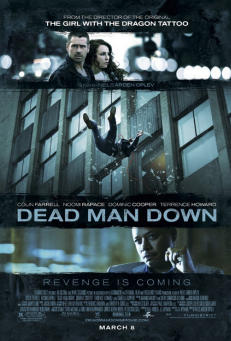By Jeremy Hannaford (Contributor) – Email
Print Edition: March 20, 2013
 In the opening scene of Dead Man Down, Colin Farrell’s character is receiving a thoughtful speech from his friend about his meaningful connection with his family and why it makes him feel important. The meaning of the scene to the audience is as empty as Colin Farrell’s infinite gaze. It isn’t until much later on that we realize the full intent of the scene. This procedure of revealing the importance of scenes well after they have come and gone becomes routine in the movie.
In the opening scene of Dead Man Down, Colin Farrell’s character is receiving a thoughtful speech from his friend about his meaningful connection with his family and why it makes him feel important. The meaning of the scene to the audience is as empty as Colin Farrell’s infinite gaze. It isn’t until much later on that we realize the full intent of the scene. This procedure of revealing the importance of scenes well after they have come and gone becomes routine in the movie.
Dead Man Down is tale of revenge. But from whose point of view, you are uncertain. Continuity doesn’t describe this confusion more so than narrative source. The film starts from Viktor’s (Colin Farrell) perspective as it follows his actions in the world of criminal activity. While his motives are unclear at first, he seems driven to meet the ends. Soon he meets Beatrice (Noomi Rapace), a woman who bares scars on her face. Noomi Rapace channels a broken version of herself. A women who was appreciated her beauty now fears the very thing she nurtured.
But then an abrupt conjuncture reveals itself between the two that was unknown to the audience yet both of them knew about it. This sudden twist comes off as clunky because the audience had no inclination of there being a twist to begin with. When a similar kind of reveal occurred in The Sixth Sense, it was shocking but it was relevant to what the audience had experienced. In the case of Dead Man Down; it is random and confusing.
And this isn’t the first time that this happens. The narrative truly begins to lose focus as the switch between the audiences being unaware of the characters intentions to the audience being able to see something so unbelievably evident yet the other characters can’t see it is stressing.
Director Neils Arden Oplev works once again with Noomi Rapace. The two collaborated on the films that launched Rapace’s career in western cinema, the original Swedish The Girl with the Dragon Tattoo series. But unlike their previous work, the story they are portraying isn’t as well made or organized. Just because you add big names to something incoherent doesn’t mean it will make it coherent.
For almost the entire film, it displays the self-damaging conditions of revenge and how even bad people can find happiness. The film almost tries to be different by trying to say that revenge isn’t always the answer. Why kill for those who are dead and buried when you are still able to live? But this is all thrown to the wayside in the final minutes as it reverses its approach and just chooses straight out revenge. It has its moments, both entertaining and boring, but it can’t hide its inconstancies.
The film is a blotchy yet peculiar kind of clutter, especially in its production. Eyebrows could be raised during the opening credits as it is revealed that WWE Films produced this features. Yes, World Wrestling Entertainment is making movies that don’t feature their “athletes” as leading characters. Wrestler Wade Barrett does have a small role in the film, but actual actors make up the rest of the cast.
I have a suspicious feeling that this film only got off the ground because of WWE’s funding. When the wrestling entertainment industry is producing films that acquire talent like Noomi Rapace and director Neils Arden Oplev, I don’t know whether to be intrigued or terrified.


